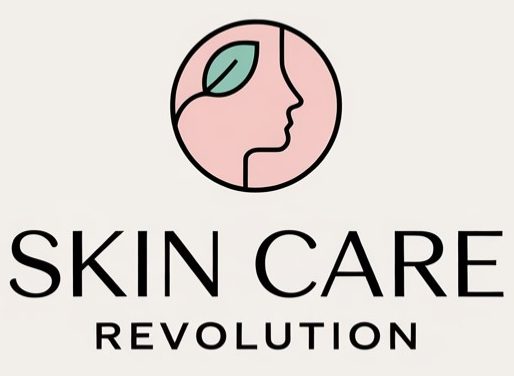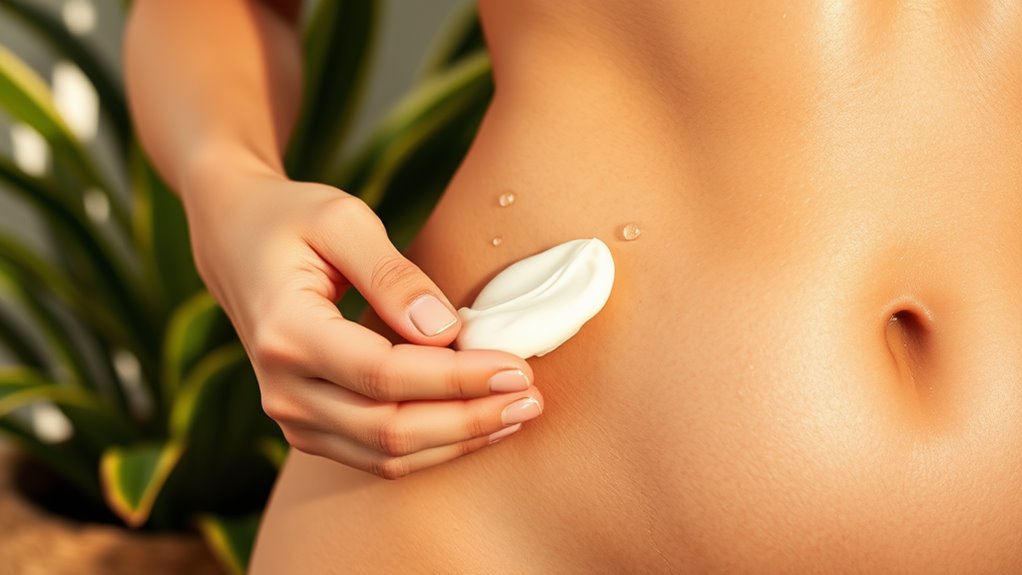The Secret to Preventing Stretch Marks Early
If you’re looking to prevent stretch marks before they appear, it’s essential to understand the factors at play. Hydration, nutrition, and a solid skincare routine all play vital roles in maintaining skin elasticity. But what specific steps can you take to enhance your skin’s resilience? Exploring these strategies can make a significant difference in your skin’s health and appearance. Let’s uncover the secrets that can help you stay ahead of stretch marks.
Key Takeaways
- Stay well-hydrated by drinking at least 8 glasses of water daily to maintain skin elasticity and prevent stretch marks.
- Incorporate a balanced diet rich in Vitamins C, E, Zinc, and Omega-3 fatty acids to support skin health and resilience.
- Establish a consistent skincare routine that includes moisturizing with ingredients like hyaluronic acid or cocoa butter to enhance skin hydration.
- Maintain a healthy weight and engage in regular exercise to improve circulation and support skin elasticity.
- Manage stress through practices like yoga or meditation, as stress can impact skin health and contribute to stretch mark development.
Understanding Stretch Marks: Causes and Risk Factors
While you may not think much about them, understanding stretch marks is essential, especially if you’re concerned about preventing them.
These marks occur when your skin stretches rapidly due to factors like pregnancy, weight gain, or puberty. They form when the dermis—the middle layer of your skin—loses its elasticity.
Genetics also plays a role; if your family members have stretch marks, you’re more likely to develop them too. Hormonal changes can weaken your skin’s structure, increasing their likelihood.
By recognizing these causes and risk factors, you can take proactive steps towards prevention. Incorporate strategies like maintaining a healthy weight and using topical treatments to support your skin’s resilience against stretch marks.
Mastering this knowledge empowers you to protect your skin effectively.
Importance of Hydration in Skin Health
Staying hydrated is key for maintaining your skin’s elasticity, which helps prevent stretch marks. You should aim for a certain amount of water each day to keep your skin nourished and resilient. Understanding how hydration impacts stretch marks can empower you to take proactive steps for healthier skin. Additionally, incorporating antioxidant-packed fruits into your diet can further support skin hydration and resilience.
Hydration Boosts Skin Elasticity
Hydration plays an essential role in maintaining your skin’s elasticity and overall health.
When you keep your skin well-hydrated, you enhance its ability to stretch without developing stretch marks.
Here are four key reasons hydration boosts skin elasticity:
-
Enhanced Cell Function: Hydrated skin cells function efficiently, leading to better repair and maintenance.
-
Improved Circulation: Adequate hydration promotes blood flow, delivering essential nutrients to skin layers.
-
Increased Collagen Production: Water supports collagen synthesis, which is vital for skin firmness and elasticity.
-
Barrier Function: Proper hydration strengthens the skin’s barrier, preventing moisture loss and maintaining suppleness.
Water Intake Recommendations
To maintain ideal skin health, understanding water intake recommendations is essential. Proper hydration enhances your skin’s resilience and overall appearance. Aim for at least 8 glasses of water daily, but adjust based on your activity level and environment. Consider the table below for a quick reference:
| Activity Level | Recommended Water Intake |
|---|---|
| Sedentary | 8 glasses (64 oz) |
| Moderately Active | 10 glasses (80 oz) |
| Active | 12 glasses (96 oz) |
| Hot Climate | 10-12 glasses (80-96 oz) |
| Pregnant/Breastfeeding | 10-12 glasses (80-96 oz) |
Listen to your body’s signals and drink water consistently throughout the day. Hydration is a key player in achieving and maintaining beautiful, healthy skin.
Hydration and Stretch Marks
While many factors contribute to the development of stretch marks, maintaining proper hydration plays an essential role in skin health.
When your skin’s hydrated, it remains more elastic and resilient, reducing the likelihood of stretch marks forming.
Here’s how hydration supports your skin:
-
Enhances Elasticity: Well-hydrated skin stretches more easily, adapting to changes without tearing.
-
Improves Circulation: Adequate water intake boosts blood flow, delivering crucial nutrients for skin repair.
-
Supports Cell Regeneration: Hydration aids in the turnover of skin cells, promoting a healthier appearance.
-
Prevents Dryness: Moist skin is less prone to irritation and damage, which can lead to stretch marks.
Nutritional Strategies to Support Skin Elasticity
To keep your skin elastic and healthy, focusing on the right nutrients is key. Incorporating foods rich in vitamins and minerals can greatly enhance your skin’s resilience. Additionally, including foods that boost collagen production can further support skin elasticity and overall health.
Essential Nutrients for Elasticity
When you’re aiming to maintain skin elasticity and prevent stretch marks, focusing on essential nutrients can make a significant difference.
Incorporating these key nutrients into your diet will support your skin’s health and resilience:
-
Vitamin C – Vital for collagen production, it helps maintain skin structure and firmness.
-
Vitamin E – An antioxidant that protects skin cells from damage and enhances moisture retention.
-
Zinc – Integral for skin repair and regeneration, promoting overall elasticity.
-
Omega-3 Fatty Acids – Found in fish and flaxseeds, they support skin barrier function and hydration.
Hydration and Skin Health
Maintaining proper hydration is essential for skin health, as it directly impacts elasticity and overall appearance. When your skin’s moisture levels are ideal, it remains plump and resilient, which helps prevent stretch marks.
To achieve this, drink plenty of water throughout the day, aiming for at least eight 8-ounce glasses. Incorporate hydrating beverages like herbal teas and natural fruit-infused waters to enhance your intake. Additionally, consider using a humidifier in dry environments to combat moisture loss.
Don’t forget to moisturize regularly with products that contain hyaluronic acid or glycerin, as these ingredients attract water to your skin. By prioritizing hydration, you’re laying the groundwork for supple skin and reducing the likelihood of developing stretch marks.
Foods to Incorporate Daily
Incorporating the right foods into your daily diet can greatly boost your skin’s elasticity and resilience. To enhance your skin’s health and prevent stretch marks, focus on these nutrient-rich options:
-
Avocados – Packed with healthy fats and vitamins E and C, they promote collagen production.
-
Berries – Rich in antioxidants, they protect your skin from damage and support healing.
-
Nuts and Seeds – These provide essential fatty acids and zinc, vital for skin repair and elasticity.
-
Leafy Greens – High in vitamins A and C, they help maintain skin structure and firmness.
Effective Skincare Routines for Prevention
To effectively prevent stretch marks, establishing a consistent skincare routine is essential.
Start by cleansing your skin daily to remove impurities and promote healthy cell turnover. Follow up with a rich moisturizer that contains hyaluronic acid or cocoa butter, as these ingredients deeply hydrate and improve skin elasticity.
Don’t overlook the importance of regular exfoliation; exfoliating 1-2 times a week can help slough off dead skin cells and stimulate new growth. Incorporate oils like vitamin E or rosehip oil into your routine, applying them to targeted areas prone to stretch marks. Additionally, consider using all-natural stretch mark butter, as it can provide extra nourishment and support skin elasticity.
Finally, always remember to stay hydrated. Drinking enough water supports skin health from the inside out, making your skincare efforts even more effective in preventing stretch marks.
Lifestyle Changes to Minimize Stretch Marks
While a solid skincare routine is essential, making certain lifestyle changes can greatly reduce your risk of developing stretch marks.
By adopting healthier habits, you empower your skin to remain resilient and elastic. Here are four key lifestyle changes to reflect on:
-
Stay Hydrated: Drink plenty of water daily to maintain skin elasticity and promote overall health.
-
Balanced Diet: Incorporate foods rich in vitamins A, C, and E, along with zinc and omega-3 fatty acids to nourish your skin.
-
Regular Exercise: Engage in physical activities to improve circulation and maintain a healthy weight, reducing the likelihood of rapid stretching.
-
Manage Stress: Practice stress-reduction techniques like yoga or meditation, as stress can affect your skin’s health.
Additionally, consider using natural remedies that can enhance your efforts, such as essential oils for stretch marks, which can provide additional nourishment and support to your skin.
Embrace these changes for ideal skin wellness!
When to Seek Professional Advice for Stretch Marks
If you’re noticing significant changes in your skin, it might be time to seek professional advice about stretch marks.
Consider consulting a dermatologist if your stretch marks are deepening, changing color, or becoming painful. Early intervention can help you explore effective treatments like laser therapy, topical retinoids, or microdermabrasion.
If you’re pregnant, gain weight rapidly, or have a family history of stretch marks, discussing your concerns with a professional can provide tailored preventive strategies. Additionally, incorporating DIY body butter into your routine can be a beneficial natural remedy for skin hydration and elasticity.
Remember, the sooner you address the issue, the better your chances of minimizing their appearance. Don’t hesitate to ask questions and express your goals; a proactive approach empowers you to make informed decisions about your skin health.
Your confidence deserves it.
Frequently Asked Questions
Can Genetics Influence the Likelihood of Developing Stretch Marks?
Yes, genetics can greatly influence your likelihood of developing stretch marks. If your family has a history of them, you might be more prone to experience similar skin changes during periods of growth or hormonal shifts.
Are There Specific Products Recommended for Preventing Stretch Marks?
To prevent stretch marks, you should consider using products rich in hyaluronic acid, cocoa butter, or vitamin E. Regularly applying these can help maintain skin elasticity and hydration, reducing the chances of developing stretch marks.
Can Men Also Get Stretch Marks?
Yes, men can get stretch marks, especially during rapid weight gain, muscle building, or hormonal changes. It’s important to stay aware of your body and consider preventive measures to minimize their appearance.
Is It Possible to Remove Existing Stretch Marks Completely?
You can’t completely remove existing stretch marks, but treatments like laser therapy and chemical peels can greatly reduce their appearance. Embracing healthy skin care routines also helps improve overall skin texture and tone.
Do Stretch Marks Change Color Over Time?
Yes, stretch marks do change color over time. Initially, they may appear red, purple, or dark brown, but as they mature, they typically fade to a lighter shade, often becoming silvery or white.

